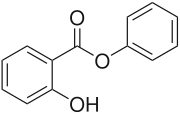Phenyl salicylate, or salol, is the organic compound with the formula C6H5O2C6H4OH. It is a white solid. It is occasionally used in sunscreens and as an antiseptic.[3]
 | |
 | |
| Names | |
|---|---|
| Preferred IUPAC name Phenyl 2-hydroxybenzoate | |
| Other names Salol | |
| Identifiers | |
3D model (JSmol) | |
| ChEBI | |
| ChEMBL | |
| ChemSpider | |
| ECHA InfoCard | 100.003.873 |
| EC Number |
|
| KEGG | |
| MeSH | C026041 |
PubChem CID | |
| UNII | |
CompTox Dashboard (EPA) | |
| |
| |
| Properties | |
| C13H10O3 | |
| Molar mass | 214.22 g/mol |
| Appearance | White solid |
| Density | 1.25 g/cm3 |
| Melting point | 41.5 °C (106.7 °F; 314.6 K) |
| Boiling point | 173 °C (343 °F; 446 K) at 12 mmHg |
| 1 g/6670 mL | |
| -123.2·10−6 cm3/mol | |
Refractive index (nD) | 1.615[2] |
| Pharmacology | |
| G04BX12 (WHO) | |
| Hazards | |
| Flash point | 137.3[2] °C (279.1 °F; 410.4 K) |
Except where otherwise noted, data are given for materials in their standard state (at 25 °C [77 °F], 100 kPa). | |
Production and reactions
The title compound was synthesized first in 1883 by the Polish chemist and doctor Marceli Nencki (who didn't publish his findings) and then independently in 1885 by the German chemist Richard Seifert (de) (1861–1919) (who did publish his findings). It is synthesized by heating salicylic acid with phenol in the presence of phosphoryl chloride.[4] It also arises from heating salicylic acid:[5]
- 2 HOC6H4CO2H → C6H5O2C6H4OH + CO2 + H2O
The conversion entails dehydration and decarboxylation. Heating phenyl salicylate in turn gives xanthone.[6][3]
- 2 C6H5O2C6H4OH → 2 C6H5OH + O[C6H4]2CO + CO2
In this conversion, phenol is produced as well as carbon dioxide.
Salol reaction
In the salol reaction, phenyl salicylate reacts with o-toluidine in 1,2,4-trichlorobenzene at elevated temperatures to the corresponding amide o-salicylotoluide.[7] Salicylamides are a type of drug.
Medical
It has been used as an antiseptic[8] based on the antibacterial activity upon hydrolysis in the small intestine.[9]
History
The Swiss physician Hermann Sahli (sometimes spelled "Saly") (1856–1933) sought a substitute for sodium salicylate, which was used as a treatment for rheumatoid arthritis but which wasn't tolerated by some patients. So Dr. Sahli asked the Polish chemist and doctor Marceli Nencki of Bern, Switzerland, if he knew of a salicylate compound that lacked sodium salicylate's side effects.[11] Nencki recommended phenyl salicylate, which he had synthesized circa 1883.[12][13] While Nencki had been investigating how phenyl salicylate behaved in the body, he hadn't published his findings.[14] Meanwhile, the German chemist Richard Seifert (de) (1861–1919), a student of the German chemist Rudolf Wilhelm Schmitt (de) (1830–1898),[15] independently synthesized phenyl salicylate in 1885.[16] In 1885, Seifert accepted a position at the Heyden chemical corporation (de) of Radebeul, Germany, which manufactured salicylic acid.[17] The United States granted to Nencki and Seifert a patent for the production of phenyl salicylate,[18] whereas Germany granted a patent for its production to Nencki and the Heyden corporation.[19] The Heyden company subsequently sold phenyl salicylate as a pharmaceutical, under the commercial name "Salol",[20] a contraction of "SALicylate of phenOL".[21] Among other applications,[22] Salol was used as an orally administered antiseptic for the small intestine, where the compound is hydrolyzed into salicylic acid and phenol.[18]
See also
Phenyl salicylate is used in school laboratory demonstrations on how cooling rates affect crystal size in igneous rocks, and can be used to demonstrate seed crystal selectiveness.[citation needed]